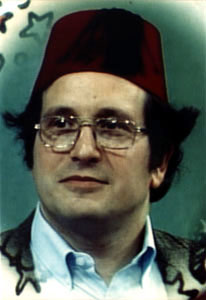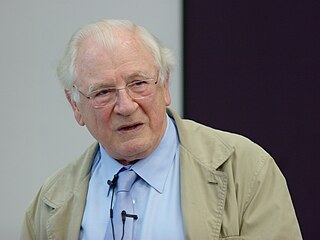Logic programming is a programming, database and knowledge-representation and reasoning paradigm which is based on formal logic. A program, database or knowledge base in a logic programming language is a set of sentences in logical form, expressing facts and rules about some problem domain. Major logic programming language families include Prolog, Answer Set Programming (ASP) and Datalog. In all of these languages, rules are written in the form of clauses:
Prolog is a logic programming language associated with artificial intelligence and computational linguistics.

Gerald Jay Sussman is the Panasonic Professor of Electrical Engineering at the Massachusetts Institute of Technology (MIT). He has been involved in artificial intelligence (AI) research at MIT since 1964. His research has centered on understanding the problem-solving strategies used by scientists and engineers, with the goals of automating parts of the process and formalizing it to provide more effective methods of science and engineering education. Sussman has also worked in computer languages, in computer architecture, and in Very Large Scale Integration (VLSI) design.
In computer science, declarative programming is a programming paradigm—a style of building the structure and elements of computer programs—that expresses the logic of a computation without describing its control flow.

In artificial intelligence, symbolic artificial intelligence is the term for the collection of all methods in artificial intelligence research that are based on high-level symbolic (human-readable) representations of problems, logic and search. Symbolic AI used tools such as logic programming, production rules, semantic nets and frames, and it developed applications such as knowledge-based systems, symbolic mathematics, automated theorem provers, ontologies, the semantic web, and automated planning and scheduling systems. The Symbolic AI paradigm led to seminal ideas in search, symbolic programming languages, agents, multi-agent systems, the semantic web, and the strengths and limitations of formal knowledge and reasoning systems.
The Fifth Generation Computer Systems was a 10-year initiative begun in 1982 by Japan's Ministry of International Trade and Industry (MITI) to create computers using massively parallel computing and logic programming. It aimed to create an "epoch-making computer" with supercomputer-like performance and to provide a platform for future developments in artificial intelligence. FGCS was ahead of its time, and its excessive ambitions led to commercial failure. However, on a theoretical level, the project spurred the development of concurrent logic programming.
In the history of artificial intelligence, neat and scruffy are two contrasting approaches to artificial intelligence (AI) research. The distinction was made in the 70s and was a subject of discussion until the middle 80s.

Robert Anthony Kowalski is an American-British logician and computer scientist, whose research is concerned with developing both human-oriented models of computing and computational models of human thinking. He has spent most of his career in the United Kingdom.
In computer science, the scientific community metaphor is a metaphor used to aid understanding scientific communities. The first publications on the scientific community metaphor in 1981 and 1982 involved the development of a programming language named Ether that invoked procedural plans to process goals and assertions concurrently by dynamically creating new rules during program execution. Ether also addressed issues of conflict and contradiction with multiple sources of knowledge and multiple viewpoints.
In computer science, the Actor model, first published in 1973, is a mathematical model of concurrent computation.
Patrick John Hayes FAAAI is a British computer scientist who lives and works in the United States. As of March 2006, he is a senior research scientist at the Institute for Human and Machine Cognition in Pensacola, Florida.
Indeterminacy in concurrent computation is concerned with the effects of indeterminacy in concurrent computation. Computation is an area in which indeterminacy is becoming increasingly important because of the massive increase in concurrency due to networking and the advent of many-core computer architectures. These computer systems make use of arbiters which gives rise to indeterminacy.

The history of artificial intelligence (AI) began in antiquity, with myths, stories and rumors of artificial beings endowed with intelligence or consciousness by master craftsmen. The seeds of modern AI were planted by philosophers who attempted to describe the process of human thinking as the mechanical manipulation of symbols. This work culminated in the invention of the programmable digital computer in the 1940s, a machine based on the abstract essence of mathematical reasoning. This device and the ideas behind it inspired a handful of scientists to begin seriously discussing the possibility of building an electronic brain.
In computer science, the Actor model, first published in 1973, is a mathematical model of concurrent computation. This article reports on the later history of the Actor model in which major themes were investigation of the basic power of the model, study of issues of compositionality, development of architectures, and application to Open systems. It is the follow on article to Actor model middle history which reports on the initial implementations, initial applications, and development of the first proof theory and denotational model.
A deductive language is a computer programming language in which the program is a collection of predicates ('facts') and rules that connect them. Such a language is used to create knowledge based systems or expert systems which can deduce answers to problem sets by applying the rules to the facts they have been given. An example of a deductive language is Prolog, or its database-query cousin, Datalog.

John Alan Robinson was a philosopher, mathematician, and computer scientist. He was a professor emeritus at Syracuse University.
Richard Jay Waldinger is a computer science researcher at SRI International's Artificial Intelligence Center whose interests focus on the application of automated deductive reasoning to problems in software engineering and artificial intelligence.

Carl Eddie Hewitt was an American computer scientist who designed the Planner programming language for automated planning and the actor model of concurrent computation, which have been influential in the development of logic, functional and object-oriented programming. Planner was the first programming language based on procedural plans invoked using pattern-directed invocation from assertions and goals. The actor model influenced the development of the Scheme programming language, the π-calculus, and served as an inspiration for several other programming languages.
The history of the programming language Scheme begins with the development of earlier members of the Lisp family of languages during the second half of the twentieth century. During the design and development period of Scheme, language designers Guy L. Steele and Gerald Jay Sussman released an influential series of Massachusetts Institute of Technology (MIT) AI Memos known as the Lambda Papers (1975–1980). This resulted in the growth of popularity in the language and the era of standardization from 1990 onward. Much of the history of Scheme has been documented by the developers themselves.




